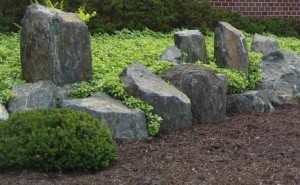Landscape Mulches and More
 March 23, 2012
March 23, 2012
It is good to know that one of the best things you can do for your garden or landscape is mulching. This practice has been use for many years, but is a bit of a new topic for us. Here are some amazing facts about mulches.
What are these Mulches?
Mulches are the materials that are used to cover the soil or plants. They can be organic and inorganic in nature depending on the purpose you are using them for.
What are Organic and Inorganic Mulches?
Organic mulches are the organic materials such as leaves, grass clippings, compost, twigs, bark, hay, straw etc. Organic mulches gift your garden with benefits like maintaining even soil temperatures, reduce evaporation, reduce soil compaction and increase soil microbial activity they help slow down the growth of weeds and act as a good source of nutrients for your garden. These organic mulches should not be installed on top of weed barrier materials.
Mulches made of rock, shredded rubber, pebbles, gravel, plastic, glass and weed fabrics are mentioned as inorganic mulches. They are generally used for decoration and provide no nutrients to the soil. These types of mulches are often installed over a permeable landscape fabric.
We used a mink colored shredded wood mulch on a landscape project in Eden Prairie, Minnesota in the picture shown.
What exactly do Inorganic Mulches do?
Inorganic mulches help in gathering heat and accumulating organic matter around the soil of your plants. They do not break down and less top dressing is required. These are mostly used for decoration purpose.
Main Benefits of Mulching:
A good layer of mulching helps the soil conserve moisture and helps to avoid weed growth. Organic mulches help by adding humus to the soil and preventing erosion. It prevents the splashing up of soil onto the plants thereby reducing the soil-borne diseases.
Is Shredded Rubber or Rock Mulches Harmful to the Plants?
No. Shredded rubber and rocks prevent the destruction of plants during its manufacturing process. They do not break down and there is no need of replacing them. Additionally, they stay looking fantastic, and hold their color forever. They also weigh more and tend to stay where you installed them. If you are planning for rock mulches then avoid plastic as your weed barriers. Do this only if you need to keep the water away from the foundation of building. Plastic slows down the flow of water and air circulation, instead use a permeable landscape, weed barrier, fabric.
How to Select Mulch?
Be specific and clear to decide the purpose for which you are going to use mulch. If looks play the important role for you, then choose the mulch which you find most attractive and fits the aesthetics of the around the area you are installing it. Always use small pieces such as small pieces of bark and shredded cypress when you are mulching around annuals and delicate perennials.
If you are planning on mulching to prevent weeds or to provide nutrients then use organic mulches such as straw, hay, shredded leaves and bark for your garden.
Is there any need to replace Organic Mulches Regularly?
Organic mulches need to be replaced or topped up every 6 months as they give up all the nutrients available in them. Here in Minnesota we tend to top dress each season.  With water flow around them, the organic mulches get washed away slowly. So, there is a need of topping them, this new top dressing also provides a nice fresh look to your garden.
Is Weeding Necessary Before Mulching?
Yes, weeding is necessary. Use an herbicide to kill the weeds around the plants, being careful not to over spray on something that you do not want to kill.
How to Use Preen with a Mulch?
Preen is a pre-emergent herbicide for your plants. It is a good alternative for the weed barriers. You need to weed the area thoroughly before using it. Preen only avoids new weeds from growing and will not remove old weeds that are already present. Preen can be sprinkled on the top of mulches and gently watered in.

 Posted in
Posted in  content rss
content rss